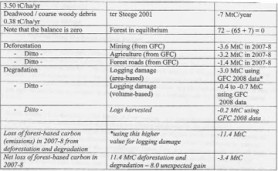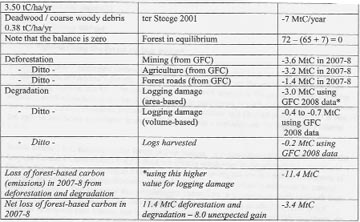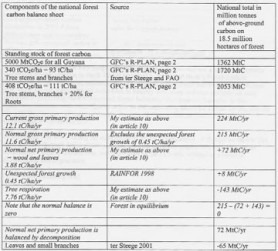(This is the final piece in a 10-part series intended to look at some of the issues surrounding Guyana’s bid for funds from the World Bank-administered Forest Carbon Partnership Fund (FCPF) and from Norway, and for the President’s Low Carbon Development Strategy.)
By Janette Bulkan
In my last article I estimated carbon emissions due to logging and from natural decay and decomposition in Guyana’s forests. These losses from forests are the equivalent of emissions from factory exhaust stacks. The losses must be assessed alongside the gains in carbon and the standing stock of carbon in the trees, if Guyana is to participate in carbon trading schemes under the rubric of REDD (Reduced Emissions from Deforestation and Degradation). REDD is one of the approaches being negotiated internationally towards a replacement for the Kyoto Protocol 1997.

Our dynamically stable forests, like those of most of the Amazon Basin, are thus unlike those forests in the Caribbean Islands which are subject to severe damage by hurricanes at irregular intervals. These recovering forests in the Islands are therefore more dynamic than our unlogged forest, in the sense of partitioning a greater proportion of carbon to creating new wood (timber) and less to respiration to maintain big old trees.
Because of the extreme infertility of most of our forest-covered hinterland soils, gross production is limited by shortage of soil nutrients such as nitrogen and phosphorus. Our standing biomass (and thus the standing stock of forest carbon) is much less than in forests on more fertile soils, including most of the Amazon Basin. This makes our forests much less likely to be convertible to financially-profitable ecologically-sustainable agriculture than in neighbouring Brazil.
Gross and net primary forest production
There does not seem to have been research on gross and net primary production of tropical rain forest in Guyana as there has been in Africa and Asia. I have therefore used the ratio from the Japanese studies in South East Asia of net primary production = 1/3 of gross primary production. That is, 2/3 of the carbon absorbed by the forest through photosynthesis (article 2 in this series) soon returns back to the atmosphere as carbon dioxide from respiration. Gross primary production is estimated at 12.1 tonnes of carbon per hectare per year (tC/ha/yr), normal net primary production (leaves and wood) as 3.9 tC/ha/yr and respiration loss of carbon as 7.8 tC/ha/yr, together with the 0.45 tC/ha/yr of “unexpected gain” in wood which I mentioned in article 7 of this series.
The normal net primary production (3.88 tC/ha/yr) can be partitioned into 3.50 tC/ha/yr of leaves and 0.38 tC/ha/yr of normal growth of branches and stem wood.
The reader may wonder at this point how the forest accumulates its standing stock of carbon, if gain and loss are almost exactly balanced in mature climax rainforest. The answer is that over perhaps 99 per cent of the forest the wood does accumulate slowly year by year (trees get bigger) but natural mortality occurs over about 1 per cent of the forest annually, mostly by the death of single trees, and the whole of the in-wood carbon of that 1 per cent is lost rapidly back to the atmosphere through natural decay and decomposition.
I now provide a tabular summary of the estimates made in articles 7-10 in this series. A plus in the last column means carbon gain, a minus in the last column means carbon loss (emission):
It is obvious that these are very rough estimates, and the GFC has laid out a scheme for greatly improving our knowledge, in the R-PLAN proposed to the World Bank’s Forest Carbon Partnership Fund. However, collecting that information from scratch will be a lengthy process and would require a government dedication to forestry field work and data analysis not seen since the 1960s during the FAO-assisted Forest Industries Development Surveys. In the meantime, Guyana needs some figures to put on the negotiating tables for carbon trading and for the 15th Conference of Parties of the UN Framework Convention on Climate Change, in Copenhagen in December 2009.
At this point, it is worth noting the differences in orders of magnitude. Although we take in 224 MtC annually through forest photosynthesis, the trees promptly respire 143 MtC back to the atmosphere. What is controllable, and negotiable, is the 11.4 MtC emitted as a result of deforestation and degradation.







